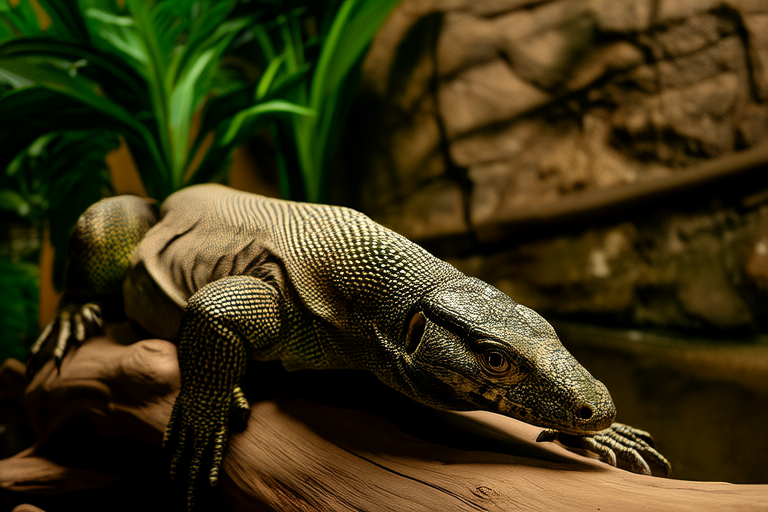From Jungle to Home: How to Make Your Water Monitor Feel Right at Ease
Welcome to the world of water monitor care! Owning a water monitor can be an incredibly rewarding experience, but it comes with significant responsibilities. This guide aims to provide you with all the information necessary to set up the perfect habitat for your water monitor, ensuring that it thrives in its new home.
Setting Up the Perfect Habitat
Tank Size
The first step in creating a suitable environment for your water monitor is selecting the right tank. Water monitors are large, active reptiles that require ample space to move around comfortably. A tank that measures at least 8 feet long, 4 feet wide, and 4 feet deep is recommended for an adult water monitor. Smaller tanks can lead to stress and health issues due to cramped conditions.
Water Quality
Water quality is crucial for maintaining the health of your water monitor. The tank should have clean, dechlorinated water that is free from harmful chemicals. Regular water changes are essential; aim to change about 25% of the water weekly. Investing in a high-quality filtration system will help keep the water clean and reduce the frequency of water changes. Additionally, consider using a UVB light to provide essential vitamin D3 for calcium absorption.
Temperature Requirements
Maintaining the correct temperature gradient within the tank is vital for your water monitor’s well-being. The ideal temperature range is between 85°F and 95°F (29°C to 35°C) during the day and can drop slightly at night, but not below 75°F (24°C). Use multiple thermometers placed at various points within the tank to monitor temperatures accurately. Heat lamps or under-tank heaters can be used to achieve the desired warmth.
Dietary Needs
Water monitors have voracious appetites and require a balanced diet to maintain optimal health. Their diet should consist of a variety of protein sources, including rodents, fish, insects, and occasional fruits or vegetables. Juvenile water monitors should be fed daily, while adults can be fed every two to three days. Ensuring a diverse diet helps prevent nutritional deficiencies and promotes overall health.
Feeding Tips
When feeding your water monitor, it’s important to handle prey items carefully to avoid injury. Use tongs or forceps to place food in the tank. Offering live food occasionally can stimulate natural hunting instincts, but be cautious as live prey may injure your pet if not consumed promptly. Always supervise feeding sessions to prevent overfeeding or aggressive behavior towards handlers.
Handling and Socialization
Proper handling techniques are crucial for establishing trust with your water monitor. Start by allowing it time to acclimate to its new surroundings before attempting to handle it. Once ready, gently pick up your water monitor using both hands, supporting its body firmly but gently. Avoid sudden movements and always approach calmly. Regular handling can help build a bond between you and your pet, making interactions more enjoyable for both parties.
Socialization
Socializing your water monitor involves gradually introducing it to different stimuli and experiences. This can include exposing it to various sounds, smells, and textures. Positive reinforcement through gentle praise or treats can encourage good behavior during these interactions. Consistency in routine and positive reinforcement plays a key role in fostering a trusting relationship.
Common Challenges and Solutions
Stress and Health Issues
One of the most common challenges faced by water monitor owners is managing stress-related behaviors. Signs of stress may include excessive hiding, reduced appetite, or abnormal swimming patterns. To alleviate stress, ensure the tank provides plenty of hiding spots and a consistent environment. Regular veterinary check-ups can also help identify and address any underlying health concerns early.
Bathing and Shedding
Water monitors need regular baths to stay healthy. Provide a shallow pool of warm water where they can soak. Bathing aids in shedding and helps maintain skin health. During shedding periods, monitor your pet closely to ensure it sheds properly without complications. If you notice any retained shed, consult a veterinarian for guidance.
Encouraging Responsible Ownership
Owning a water monitor requires a significant commitment in terms of time, resources, and knowledge. Before bringing one home, thoroughly research their care requirements and ensure you have the means to meet them. Consider joining local reptile groups or online forums to connect with experienced owners who can offer valuable advice and support. Remember, responsible ownership means being prepared for the long-term care of your pet.
In conclusion, providing a comfortable and stimulating environment for your water monitor is essential for its happiness and well-being. By following the guidelines outlined in this article, you’ll be well-equipped to give your water monitor the best possible life in captivity. With dedication and proper care, you and your water monitor can enjoy many years together.
